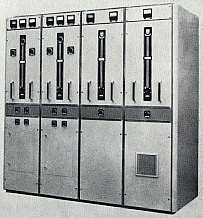| GENERAL DESCRIPTION |
 5 kW AM SHORT-WAVE TRANSMITTER TYPE SOZ 362 channelized
5 kW AM SHORT-WAVE TRANSMITTER TYPE SOZ 362 channelized| TECHNICAL SPECIFICATIONS | |
| Frequency range | 2.2-28 Mc/s in seven sub-ranges |
| Frequency tolerance | 2.2-4 Mc/s: ± 20.10-6 4-28 Mc/s: ± 15.10-6 |
| RF output (carrier) | 5 kW rated |
| RF output impedance | 600 ohms balanced (on special order 50 or 75 ohms unbalanced) |
| Standing wave ratio | max. 1.4 : 1 |
| Spurious radiation | according to CCIR recommendations |
| AF input impedance | nominal 600 ohms balanced |
| AF input level (reference 1000 c/s at 100% modulation) | 0 dbm ± 2 db (0dbm = 1 mW into 600 ohms) |
| Linear distortion (from 30 to 10,000 c/s, reference 1000 c/s at 60% modulation) | within ± 1.5 db |
| Non-linear distortion (from 50 to 10,000 at 90% modulation) | less than 3 % |
| Noise level (reference 1000 c/s at 100% modulation) | better than -60 db (unweighted) |
| Modulation capability | 100% instantaneously 60% continuously in the range 50-10,000 c/s |
| Carrier shift | less than 5% up to a modulation depth of 95% |
| Power supply | 3 x 380 V ±5%, 50 c/s or 60 c/s ±5% four-wire mains (adaptation to other voltages is possible by use of an optional, separate autotransformer) |
| Power consumption (transmitter equipped with 1 RF unit) | at 0% modulation: approx. 11 kW at 30% modulation: approx. 13 kW at 100% modulation: approx. 16 kW at stand-by: approx. 2.5 kW consumption per additional RF unit at stand-by: approx. 1.7 kW |
| Power factor | approx. 0.82 |
| Ambient temperatures | at sea level: 10° to 45° C at 6000 feet: 10° to 35° C |
| Relative humidity | up to 95% |
| Dimensions (for a transmitter with one RF unit) | height: approx. 84 in. (2120 mm) width: approx. 64 in. (1620 mm) depth: approx. 34 in. (870 mm) Minimum floorspace: 120 x 140 in. (3000 x 3500 mm) |
| Weight (for a transmitter with one RF unit) | approx. 4620 lb. (2100 kg) |
| TUBE COMPLEMENT | |||||
| RF stages | AF stages and modulator | Rectifiers | |||
| Number | Type | Number | Type | Number | Type |
| 2 | QBL5/3500 (6076) | 2 | QBL5/3500 (6076) | 3 | DCG5/5000GB (872A) |
| 3 | QQE06/40 (5894) | 6 | QE06/50 (807) | 8 | DCG4/1000G (866A) |
| 1 | OA2 | ||||
| 1 | E80L (6227) | ||||
| 1 | EF91 (6AM6) | ||||
| THIS TYPE OF TRANSMITTER IS INSTALLED IN THE FOLLOWING COUNTRIES | |||||
| ITU | Country | ITU | Country | ||